Love Letters - Fernand Léger to Franciska Clausen
The correspondence consists of a long series of messages and letters from Fernand Léger (1881 Argentan – 1955 Gif-sur-Yvette) to the artist Franciska Clausen (1899- Aabenraa -1986) during the period 1925 to 1928.
Franciska Clausen frequented Paris regularly between 1924 and 1931. From February 1924 to December 1925 she attended Léger's painting school Académie Moderne in Paris. She was quickly considered one of his best students.
In the novel “Franciska”, the author Agnete Braad envisions the story of the intimate relationship between Fernand and Franciska, which had remained a secret at the time. This correspondence confirms the relationship between the two artists.
‘The medium is the message’
While not love letters in the traditional sense, these letters document the practicalities of living out a secret love affair. Meetings and encounters are arranged, often at short notice, in telegram style with short, direct messages, what is known as ‘pneumatic delivery’. This style determines both the content and the style of the exchanges, hence, ‘the medium is the message’.
This ‘pneumatic delivery’ predates the 21st century world of communication where contemporary exchanges via social networks and apps share information and express feelings in a mere few words. It anticipates a social reality, influenced by hecticness and economic rationality, that has become the norm nowadays. In this sense, Fernand and Franciska were ahead of their time in their interactions through these letters.
Although the style throughout is prosaic and formal, there are some glimpses of emotion to be seen. One is made to believe that Franciska is considered, and treated as, an object of desire, and not partner in an emotionally equivalent relationship.
The personal form of address ‘tu’ and the impersonal form of address ‘vous’ are interspersed throughout the series of letters. Fernand tends to use the formal ‘vous’ in his short rendez-vous messages when he is doing badly, and after a dispute even using the formal address ‘Mademoiselle’. Meanwhile, he uses the personal ‘tu’, when he is doing well, or when he is worried and in need of the comfort and support of his lover.
The rhetoric pattern of Fernand Légers letters to Franciska Clausen shows a translucent similarity with his oeuvre.
Fernand Léger’s orthography and punctuation have been edited in the case of minor errors, which occur rather often; major spelling variants are kept, as they occur.
Alexander and Evelyne von Baeyer
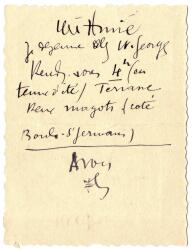
Fernand Léger
Lunch at „Deux Magots“... in casual dress.
Handwritten letter in brown ink on both sides of business card „Armand“. Signed with monogram.
10.2 x 7.9 cm.
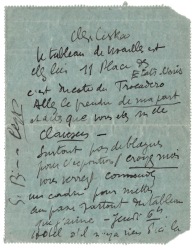
Fernand Léger
„Surtout pas de blagues pour l’exposition.“ — No jokes about the exposition.
Handwritten letter in ink. Fully signed.
c. 14.2 x 11.2 cm.
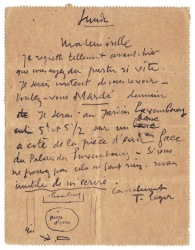
Fernand Léger
Ciska left abruptly.
Handwritten letter in brown ink with drawing. Fully signed.
14.2 x 11.2 cm.
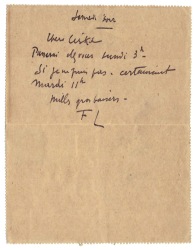
Fernand Léger
If not Monday, then Tuesday.
Handwritten letter in brown ink. Signed with monogram.
14.3 x 11.2 cm.
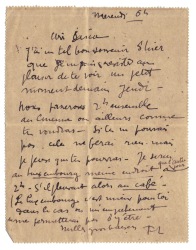
Fernand Léger
„ Je ne puis résister au plaisir de te voir“ — I cannot resist the delight to see you.
Handwritten letter in brown ink. Signed with monogram.
14.5 x 11.3 cm.
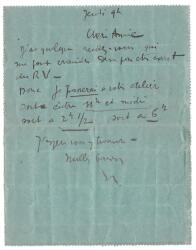
Fernand Léger
Cannot promise to be punctual.
Handwritten letter in ink. Signed with monogram.
14.2 x 11.2 cm.
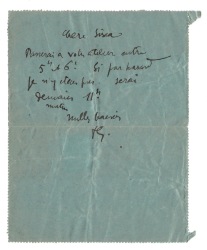
Fernand Léger
Alternative rendez-vous.
Handwritten letter in ink. Signed with monogram.
14.4 x 11.2 cm.
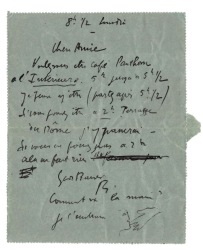
Fernand Léger
„Comment va la main ? Je l’embrasse“ — How is your hand ? I kiss it.
Handwritten letter in ink with drawing. Signed with monogram.
14.2 x c. 11.5 cm.